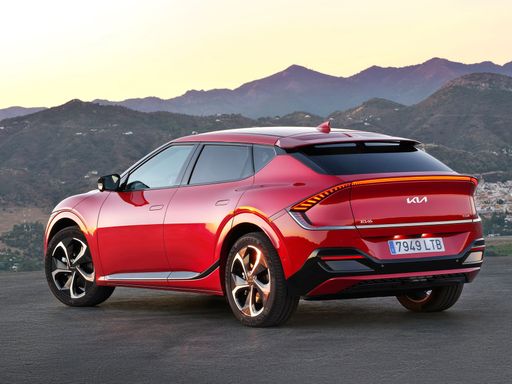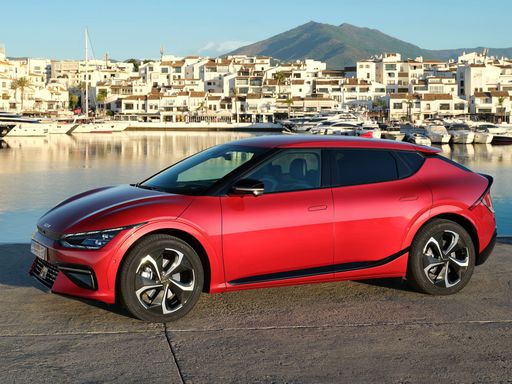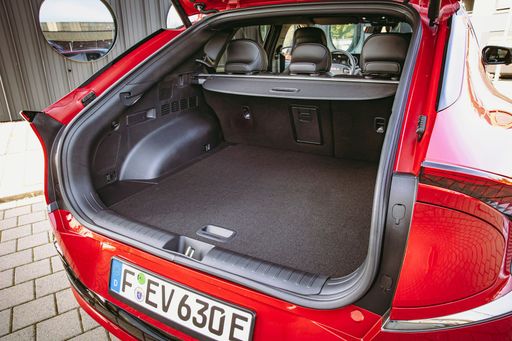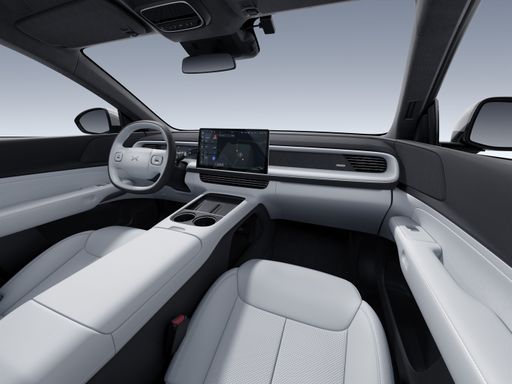In the rapidly evolving world of electric vehicles, competition is fierce as automakers strive to offer innovative solutions. Two noteworthy contenders in the SUV segment are the Kia EV6 and the XPeng G6. Both vehicles showcase advancements in technology, performance, and sustainability. In this article, we will delve into a detailed comparison of these two electric SUVs, focusing on their technical aspects and innovations.
Kia EV6 vs XPeng G6 – Which model is better for everyday use?
Compare performance, boot capacity, efficiency and price at a glance.
Find out which car is the better choice for you – Kia EV6 or XPeng G6?
Powertrain and Performance
The Kia EV6 comes equipped with various powertrain options, ranging from 170 HP in its base model to an impressive 325 HP in its top-tier variant. The vehicle offers rear-wheel drive and all-wheel drive configurations, providing flexibility for different driving preferences. With torque ratings varying from 350 Nm to 605 Nm, the EV6 can accelerate from 0-100 km/h in as little as 5.3 seconds, demonstrating its robust performance.
In comparison, the XPeng G6 excels with power outputs up to 476 HP, making it one of the most powerful electric SUVs in its class. Available in rear-wheel drive and all-wheel drive options, the G6 delivers a solid torque range of 440 to 660 Nm, enabling it to accelerate from 0-100 km/h in just 4.1 seconds in its fastest variant. With top speeds of up to 200 km/h, the G6's performance truly stands out in this competitive arena.
Battery and Range
Battery capacity plays a crucial role in an electric vehicle's overall performance, and both models impress in this area. The Kia EV6 comes with two battery options: 63 kWh and 84 kWh, offering ranges from 428 km to a remarkable 582 km on a single charge. Its energy consumption ranges from 15.9 to 17 kWh/100 km, showing commendable efficiency.
Meanwhile, the XPeng G6 offers battery options of 66 kWh and 87.5 kWh, providing electric ranges between 435 km and 570 km. Although the G6 has slightly higher consumption at around 17.5 to 17.9 kWh/100 km, its range capabilities still position it well within the competitive landscape.
Interior Space and Comfort
Space and comfort are essential factors for any SUV, and both the Kia EV6 and XPeng G6 deliver. The EV6 boasts a trunk capacity of 490 liters, which is ample for everyday use. Its spacious interior can comfortably accommodate five passengers, ensuring a pleasant driving experience.
On the other hand, the XPeng G6 provides a larger trunk capacity of 571 liters. This added space enhances practicality, particularly for families or those needing extra storage for longer trips. Both vehicles feature comfortable seating for five, but the added cargo capacity of the G6 may appeal to consumers with heavier luggage needs.
Technological Innovations
When it comes to technology, both the Kia EV6 and XPeng G6 are equipped with the latest advancements. The EV6 features a sophisticated infotainment system with a dual curved display and advanced connectivity options, ensuring an engaging driving experience. Additionally, it includes a host of driver-assistance features, enhancing safety on the road.
XPeng is well-known for its emphasis on autonomous technology, and the G6 is no exception. It showcases XPeng's patented XPILOT system, which offers a semi-autonomous driving experience and numerous safety enhancements. Both vehicles utilize advanced materials and design philosophy, contributing to their modern aesthetics and feel.
Conclusion
In summary, the Kia EV6 and XPeng G6 each possess unique strengths that cater to different consumer preferences. The EV6 impresses with its range options and overall efficiency, while the G6 shines in performance and cargo capacity. With advancements in technology continuing to shape the EV landscape, both vehicles demonstrate that electric SUVs are not just practical but also thrilling to drive.
As consumers weigh their options, the final choice may come down to specific needs—whether it's the efficiency and comfort of the Kia EV6 or the power and innovative features of the XPeng G6. Ultimately, the rise of electric vehicles is paving the way for a more sustainable future in the automotive industry.
Here’s where it gets real: The technical differences in detail
Costs and Efficiency:
Looking at overall running costs, both models reveal some interesting differences in everyday economy.
Kia EV6 has a barely noticeable advantage in terms of price – it starts at 38600 £, while the XPeng G6 costs 40800 £. That’s a price difference of around 2238 £.
In terms of energy consumption, the advantage goes to the Kia EV6: with 15.90 kWh per 100 km, it’s slightly more efficient than the XPeng G6 with 17.50 kWh. That’s a difference of about 1.60 kWh.
As for range, the Kia EV6 performs slight better – achieving up to 582 km, about 57 km more than the XPeng G6.
Engine and Performance:
Under the bonnet, it becomes clear which model is tuned for sportiness and which one takes the lead when you hit the accelerator.
When it comes to engine power, the Kia EV6 has a clearly perceptible edge – offering 609 HP compared to 487 HP. That’s roughly 122 HP more horsepower.
In acceleration from 0 to 100 km/h, the Kia EV6 is to a small extent quicker – completing the sprint in 3.50 s, while the XPeng G6 takes 4.10 s. That’s about 0.60 s faster.
In terms of top speed, the Kia EV6 performs distinct better – reaching 260 km/h, while the XPeng G6 tops out at 200 km/h. The difference is around 60 km/h.
There’s also a difference in torque: Kia EV6 pulls to a small extent stronger with 770 Nm compared to 660 Nm. That’s about 110 Nm difference.
Space and Everyday Use:
Beyond pure performance, interior space and usability matter most in daily life. This is where you see which car is more practical and versatile.
Both vehicles offer seating for 5 people.
In curb weight, Kia EV6 is slight lighter – 1955 kg compared to 2115 kg. The difference is around 160 kg.
In terms of boot space, the XPeng G6 offers a bit more room – 571 L compared to 490 L. That’s a difference of about 81 L.
In maximum load capacity, the XPeng G6 performs minimal better – up to 1374 L, which is about 84 L more than the Kia EV6.
When it comes to payload, XPeng G6 minimal takes the win – 475 kg compared to 450 kg. That’s a difference of about 25 kg.
Who wins the race?
The Kia EV6 proves to be wins the duel decisively and therefore becomes our DriveDuel Champion!
Kia EV6 is the better all-rounder in this comparison.
 @ Kia Corporation
@ Kia Corporation
Kia EV6
Kia EV6
The Kia EV6 is an impressive contender in the electric vehicle market, blending futuristic design with sustainable driving. Its sleek exterior combined with a spacious and tech-savvy interior provides both style and comfort for modern drivers. With a focus on performance, the EV6 delivers an exhilarating driving experience while maintaining an eco-friendly footprint.
details @ Kia Corporation
@ Kia Corporation
 @ Kia Corporation
@ Kia Corporation
 @ Kia Corporation
@ Kia Corporation
 @ Kia Corporation
@ Kia Corporation
 @ Kia Corporation
@ Kia Corporation
XPeng G6
The XPeng G6 looks like a sleeker, tech-rich alternative to conventional electric SUVs, with an interior that feels modern, airy and purposefully designed for everyday comfort. On the road it’s composed and surprisingly engaging, giving drivers a smart mix of calm refinement and a playful streak — not bad for a car that quietly challenges the usual premium suspects.
details @ XPeng Motors
@ XPeng Motors
 @ XPeng Motors
@ XPeng Motors
 @ Kia Corporation
@ Kia Corporation
|
 @ XPeng Motors
@ XPeng Motors
|
|
|
|
Costs and Consumption |
|
|---|---|
|
Price
38600 - 60000 £
|
Price
40800 - 44200 £
|
|
Consumption L/100km
-
|
Consumption L/100km
-
|
|
Consumption kWh/100km
15.9 - 20.9 kWh
|
Consumption kWh/100km
17.5 - 18.4 kWh
|
|
Electric Range
428 - 582 km
|
Electric Range
510 - 525 km
|
|
Battery Capacity
63 - 84 kWh
|
Battery Capacity
80 kWh
|
|
co2
0 g/km
|
co2
0 g/km
|
|
Fuel tank capacity
-
|
Fuel tank capacity
-
|
Dimensions and Body |
|
|---|---|
|
Body Type
SUV
|
Body Type
SUV
|
|
Seats
5
|
Seats
5
|
|
Doors
5
|
Doors
5
|
|
Curb weight
1955 - 2220 kg
|
Curb weight
2115 - 2220 kg
|
|
Trunk capacity
480 - 490 L
|
Trunk capacity
571 L
|
|
Length
4695 mm
|
Length
4758 mm
|
|
Width
1880 - 1890 mm
|
Width
1920 mm
|
|
Height
1545 - 1550 mm
|
Height
1650 mm
|
|
Max trunk capacity
1250 - 1290 L
|
Max trunk capacity
1374 L
|
|
Payload
440 - 450 kg
|
Payload
470 - 475 kg
|
Engine and Performance |
|
|---|---|
|
Engine Type
Electric
|
Engine Type
Electric
|
|
Transmission
Automatic
|
Transmission
Automatic
|
|
Transmission Detail
Reduction Gearbox
|
Transmission Detail
Reduction Gearbox
|
|
Drive Type
Rear-Wheel Drive, All-Wheel Drive
|
Drive Type
Rear-Wheel Drive, All-Wheel Drive
|
|
Power HP
170 - 609 HP
|
Power HP
296 - 487 HP
|
|
Acceleration 0-100km/h
3.5 - 8.7 s
|
Acceleration 0-100km/h
4.1 - 6.7 s
|
|
Max Speed
185 - 260 km/h
|
Max Speed
200 km/h
|
|
Torque
350 - 770 Nm
|
Torque
440 - 660 Nm
|
|
Number of Cylinders
-
|
Number of Cylinders
-
|
|
Power kW
125 - 448 kW
|
Power kW
218 - 358 kW
|
|
Engine capacity
-
|
Engine capacity
-
|
General |
|
|---|---|
|
Model Year
2024 - 2025
|
Model Year
2025
|
|
CO2 Efficiency Class
A
|
CO2 Efficiency Class
A
|
|
Brand
Kia
|
Brand
XPeng
|
What drive types are available for the Kia EV6?
The Kia EV6 is offered with Rear-Wheel Drive or All-Wheel Drive.
The prices and data displayed are estimates based on German list prices and may vary by country. This information is not legally binding.
